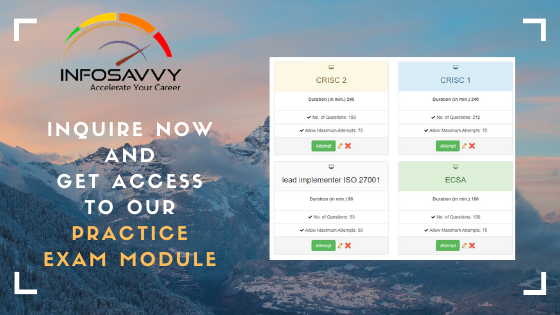The ISACA Certified in Risk and Information Systems Control is the fastest growing and the most prestigious qualification available for Information Security managers and Risk Manager. The CRISC certification is for the individual, who manages designs, oversees and/or assesses an enterprise?s information security & Risk Management.
CRISC defines the core competencies and international standards of performance that risk managers are expected to master. It provides executive management with the assurance that those who have earned their CRISC have the experience and knowledge to offer effective risk management and advice. This 4-day training program provides an intense environment in which participants will acquire the skills and knowledge needed to meet the requirements of the CRISC certification.
Upon completion of this program, students will be able to:
Demonstrate efficiency in designing, implementing, monitoring and maintaining the IS controls of the enterprise Acquire the relevant knowledge and skills required to clear the CRISC certification exam Develop a working knowledge of the 4 domains areas as prescribed by ISACA
CRISC defines the core competencies and international standards of performance that risk managers are expected to master. It provides executive management with the assurance that those who have earned their CRISC have the experience and knowledge to offer effective risk management and advice. This 4-day training program provides an intense environment in which participants will acquire the skills and knowledge needed to meet the requirements of the CRISC certification.
Upon completion of this program, students will be able to:
Demonstrate efficiency in designing, implementing, monitoring and maintaining the IS controls of the enterprise Acquire the relevant knowledge and skills required to clear the CRISC certification exam Develop a working knowledge of the 4 domains areas as prescribed by ISACA Introduction To CRISC
- Governance and Risk Management
- The Context of IT Risk Management
Risk Identification
- It Risk Management Good Practices
- Methods to identify RiskRisk Culture and Communication
- The Busines IT Risk Strategy
- Information Security Risk Concepts and Principles
- Threats and Vulnerabilities Related to Assets
- Risk Related to organizational Assets and Business Processes
- It Risk Scenarios
- Ownership and Accountability
- The IT Risk Register
- Risk Capacity, Risk appetite and Risk Tolerance
- Risk Awarenes
Risk Assessment
- Risk Identification Versus Risk Assesment
- Risk Assessment Techniques
- Analyzing Risk Scenarios
- Current State of Controls
- Risk and Control analysis
- Risk Analysis Methodologies
- Documenting Incident Response
- Business-Related Risk
- Risk Associated With Enterprise Architecture
- Data Management
- New Threats and Vulnerabilities
- Emerging Technologies
- Industry trends
- Third-party Management
- Project and Program Management
- Business Continuity and Disaster Recovery Management
- Exception Management Practices
- IT Risk Assessment Report
- Risk Ownership and Accountability
- Communicating the IT Risk Assessment Results
Risk Response
- Aligning Risk Response With Business Objectives
- Risk Response Options
- Analysis Techniques
- Vulnerabilities Associates With New Controls
- Devloping a Risk Action Plan
- Business Process Review Tools and Techniques
- Control Design and Implementation
- Control Monitoring and Effectiveness
- Characteristics of Inherent and Residual Risk
- Control Activities,Objectives,Practices and Metrics
- Systems Control Design and Implementation
- Impact of Emerging Tchnologies on Design and Implementation of Controls
- Control Ownership
- Risk Management Procedures and Documentation
- Risk Response and the Risk action Plan
Risk and Control Monitoring And Reporting
- Key risk Indicators
- Data Collection and Extraction Tools and Techniques
- Changes to the IT Risk Profile
- Monitoring Controls
- Controls Assessment Types
- Results of Controls Assessments
- Changes to the IT Risk Profile
Check out what our students have to say
Certified in Risk and Information Systems Control | CRISC
The ISACA Certified in Risk and Information Systems Control CRISC is the fastest growing and the most prestigious qualification available for Information Security managers and Risk Manager. The CRISC certification is for the individual, who manages designs, oversees and/or assesses an enterprise?s information security & Risk Management.
CRISC defines the core competencies and international standards of performance that risk managers are expected to master. Also It provides executive management with the assurance that those who have earned their CRISC have the experience and knowledge to offer effective risk management and advice. Finally this 4-day training program provides an intense environment in which participants will acquire the skills and knowledge needed to meet the requirements of the for CRISC
Also Upon completion of this program, students will be able to:
Demonstrate efficiency in designing, implementing, monitoring and maintaining the IS controls of the enterprise Acquire the relevant knowledge and skills required to clear the CRISC certification exam Develop a working knowledge of the 4 domains areas as prescribed by ISACA
Introduction To CRISC
- Governance and Risk Management
- The Context of IT Risk Management
Risk Identification
- It Risk Management Good Practices
- Methods to identify RiskRisk Culture and Communication
- The Busines IT Risk Strategy
- Information Security Risk Concepts and Principles
- Threats and Vulnerabilities Related to Assets
- Risk Related to organizational Assets and Business Processes
- It Risk Scenarios
- Ownership and Accountability
- The IT Risk Register
- Risk Capacity, Risk appetite and Risk Tolerance
- Risk Awarenes
Risk Assessment
- Risk Identification Versus Risk Assesment
- Risk Assessment Techniques
- Analyzing Risk Scenarios
- Current State of Controls
- Risk and Control analysis
- Risk Analysis Methodologies
- Documenting Incident Response
- Business-Related Risk
- Risk Associated With Enterprise Architecture
- Data Management
- New Threats and Vulnerabilities
- Emerging Technologies
- Industry trends
- Third-party Management
- Project and Program Management
- Business Continuity and Disaster Recovery Management
- Exception Management Practices
- IT Risk Assessment Report and
- Communicating the IT Risk Assessment Results
- Risk Ownership and Accountability
Risk Response
- Aligning Risk Response With Business Objectives
- Risk Response Options
- Analysis Techniques
- Vulnerabilities Associates With New Controls
- Devloping a Risk Action Plan
- Business Process Review Tools and Techniques
- Control Design and Implementation
- Control Monitoring and Effectiveness
- Characteristics of Inherent and Residual Risk
- Control Activities,Objectives,Practices and Metrics
- Systems Control Design and Implementation
- Impact of Emerging Tchnologies on Design and Implementation of Controls
- Control Ownership
- Risk Management Procedures,Documentation,?Response,Risk action Plan
Risk and Control Monitoring And Reporting
- Key risk Indicators
- Data Collection and Extraction Tools and Techniques
- Changes to the IT Risk Profile
- Monitoring Controls
- Controls Assessment Types
- Results of Controls Assessments
- Changes to the IT Risk Profile
Who Should Attend
- IT professionals
- Project managers
- Risk professionals
- Control professionals
- Compliance professionals
- Business analysts
- Any candidate can attend training who want to learn about CISM
- Internal and external auditors
- IT and Information security professionals
- IS/IT Auditors
- IT Managers
- IS/IT Consultants
- IS/IT Audit Managers
- Security Professionals
- System Analysts
- CIOs
- CTOs
- Compliance officers
- Aspirants in the field of information security and assurance
Exam Information
The exam consists of 150 multiple choice questions and is offered in the English language at hundreds of locations worldwide.
The content of the exam covers five content areas or domains, which are based on an extensive job practice analysis conducted by
industry leaders and subject matter experts from around the world, and reflect the most current practices.
The five domains contain tasks and knowledge statements which depict the tasks performed in the field and the knowledge required to perform these tasks.
Exam candidates will be tested based on their practical knowledge associated with performing these tasks.
The CRISC is designed for professionals who have three years of experience in professional-level risk control and management.
To get the CRISC credential, a professional must: Concur to abide by the CRISC Continuing Education Policy Pass the CRISC exam
Stick to the ISACA Code of Professional Ethics.
Other IT Security and Governance Courses










Reviews
There are no reviews yet.